Labels given to Ernst by authorities/NGOs since she began speaking out about Encana’s, AER’s and Alberta Environment’s contaminated water cover-up and law violations:
- That “crazy lady” at Rosebud (by Encana’s licenced land agents, media, politicians and the regulators);
- Judged a “criminal” without due process and without any evidence by AER in 2005;
- “Eco-terrorist” by AER’s outside counsel, Glenn Solomon, in an official court filing in 2012, also without any evidence, fingerprinting, charges, due process;
- “Activist” and or “Fractivist” by Canada’s NGOs, including Council of Canadians and Canadian Centre for Policy Alternatives (Why not name Ernst what she is? A frac-harmed Canadian citizen, business owner, landowner, scientist whose corporate obligations include exposing the truth);
- “Water Activist” by Lawyers Weekly Magazine (see above smears by NGOs);
- Political grandstanding “Nutcase” by AER’s outside counsel, Glenn Solomon;
- “Vexatious litigant” also without due process and without any evidence, “Unwise” and “Alice in Wonderland” by the Supreme Court of Canada in their official ruling in Ernst vs AER.
The National Self-Represented Litigants Project presents: The Self-Represented Litigants Case Law Database, Occasional Research Series (Paper 3), Substantial & Punitive Costs Awards Against Self-Represented Litigants by Ashley Haines & Julie Macfarlane, July 2018, Law Foundation of Ontario, Windsor Law and The Foundation for Legal Research
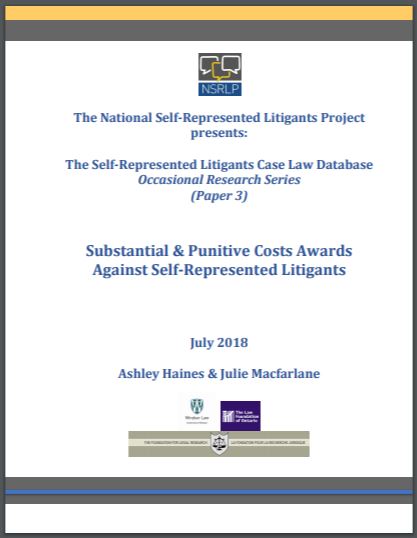
…
In April 2018, the NSRLP’s Lidia Imbrogno and Professor Julie Macfarlane published a report (Costs Awards for Self-Represented Litigants) examining how courts determine costs awards for successful SRLs. The case law presented in that report showed that while the ultimate goal of awarding costs is to indemnify the successful party, the additional goals of encouraging settlement….
…
Vexatiousness and Costs
The term “vexatious” is used to describe behavior that is harassing, annoying,
malicious, or conducted on the basis of an improper motive. When an individual is officially designated a “vexatious litigant”, they are thereafter prohibited
from continuing with their proceeding, or from starting any new proceedings
without the express permission of the court.34 Alternatively, the court may describe individuals as exhibiting ‘vexatious-style’ behavior without formally designating them as a vexatious litigant. This can include remarks about the litigant’s presentation to the court, their ability to follow instructions, or their acting in a manner that is aggressive,
obstructionist, manipulative, or deceitful.35 Based on our preliminarily findings,
it appears that vexatious-style behavior may impact overall case outcomes and
the subsequent costs awards issued against unsuccessful SRLs.36
Since the rationale for imposing substantial or (especially) punitive costs is often related to inappropriate behaviour by the losing party, we are not surprised to find a correlation between an award of substantial or punitive costs and vexatiousness. In 58% (n = 22) of the cases involving substantial or punitive costs that we have analyzed, the SRL was either officially designated as a vexatious litigant (n = 3) or, much more often, accused of ‘vexatious-style’ behavior (n = 19). Vexatious behavior is sometimes equated with acting ‘unreasonably’, 37 or in a disrespectful or disruptive manner.38 Also described as vexatious behaviour are “verbal wanderings”, 39 or failure to comply with court orders.40 [Ernst has complied with all court orders in her case while Encana has not yet Ernst has been the only one punished by the courts.]
The relationship between the imposition of substantial or punitive costs and perceived vexatious behavior by SRLs is made clear in some judicial dicta. For example, in Reilly v. Johnson and Junger Law Firm, opposing counsel claimed that the SRL’s behavior was an, “egregious abuse of the court’s process that warrants judicial reprimand.” 41 Substantial or punitive costs are also being used to discourage SRLs described as vexatious from taking future legal action. [Courts enabled AER’s and Alberta Environment’s abuse of process in Ernst’s case.]
In the recent case of NK v BH, the judge found “without doubt” that the SRL was a vexatious litigant.42 The judge noted, “Because this is the second application made by Mr. K for the same relief, based upon false allegations [Who orders Supreme Court of Canada Justice Rosalie Abella as behaving vexatiously and who orders costs against J Abella for knowingly lying about Ernst in her ruling?], I am satisfied that costs in the amount of $3,000.00 should be ordered”.43 The SRL was also prohibited by the court from filing any further applications for leave concerning JN, whom he alleged to be his child, for a period of five years.44 It appears that this costs award was issued not only in response to the SRL’s perceived vexatious behavior, but to prevent any future legal action on the behalf of the SRL.
Similarly, in the case of Droit de la famille – 16152, the court awarded costs of $8,000 against the SRL, which were intended in part to act as “a deterrent for future and frivolous litigation.”45
While it is consistent to find formal designation as a vexatious litigant
associated with increased costs, it is more concerning to see a similar correlation between increased cost and the ‘vexatious-style behaviour’ labelling of an SRL that stops short of formal designation. [Why does it stop short? No evidence? Worse, fabricated “facts” like J Abella’s?]
We have already observed significant variations in the interpretation of SRL behaviour (as
intentionally obstructive, or just the result of mistakes or misunderstandings). …
In Conclusion
- It is difficult to determine why certain provinces appear to award
substantial or punitive costs more frequently than others. … - Substantial or punitive costs awards against SRLs appear to be closely
linked to judicial discussion of vexatious behaviour (what we describe
here as ‘vexatious-style’ labelling), as well as formal designation as a
vexatious litigant. While this is less surprising where there is a formal
designation of an SRL as vexatious, it does raise a question about the
consistency and fairness with which SRL behaviour is informally characterized as intentionally vexatious. We shall be addressing this issue further in our upcoming detailed research report on vexatiousness. - There appears to be a correlation between cases that raise questions and arguments about procedural fairness – including SRLs who cause delay to court proceedings, bring forward what are determined to be frivolous claims, or conduct themselves in a manner that the court considers inappropriate – and increased awards of costs against them. This concerns us, because it is not always clear whether these are intentionally obstructive behaviours, or simply the result of a lack of understanding of the court procedure, as the Supreme Court of Canada decided in Pintea. In the alternative, SRLs who prove themselves to be
effective advocates do not seem to fare any better – we note that small
missteps in procedure may then be interpreted as deliberate actions,
rather than as a result of a lack of formal legal education. - There is some evidence in the jurisprudence to suggest that substantial or punitive costs may be being used as a measure to warn or deter SRLs from pursuing future legal action. Increased costs are an important tool to compensate a wronged party for clear and deliberate misbehavior on the part of the opposing party, and this is sometimes framed as an Access to Justice issue. However, we do not believe that this is generally a fair or effective way to reduce the growing number of people who are forced to attend court without legal representation, many of whom do so because they cannot afford legal representation. We conclude that the Access to Justice goals implicit in an award of higher-than-usual costs to a successful party may be in some tension with this reality.
Notes:
34 The Ontario Rules of Civil Procedure, supra note 7, section 2.1.01(1) indicates, “the court may, on its own initiative, stay or dismiss a proceeding if the proceeding appears on its face to be frivolous or vexatious or otherwise an abuse of the process of the court.” Under section 2.1.01(3) of the same Act, the court may also make a further order which prohibits an individual from making further motions without leave of the court. Similar provisions can be found in the Supreme Court Civil Rules, supra note 13, rule 9-5(1) “Striking Pleadings, Scandalous, frivolous or vexatious matters”; Alberta Rules of Court, supra note 11, section 14.74(c) “Application to dismiss an appeal, the appeal is frivolous, vexatious, without merit or improper”; and section 14.5(1)(j) of the same Act, “appeals only with permission, any appeal by a person who has been declared a vexatious litigant in the court appealed from”.
35 “Introducing the Self-Represented Litigant Case Law Database” supra note 1 at page 8. 36 Ibid at page 9.
37 Ascani v Robert, 2013 ONSC 2579 at para 11; NK v BH, 2017 ABPC 100 at para 20.
38 Bouchard v Bouchard, 2017 MBQB 42 at para 4; NK v BH, 2017 ABPC 100 at para 17.
39 Darlington v Moore, 2012 NSSC 84 at para 36.
40 Lalli v Grewal, 2017 BCSC 983 at para 26, 29; V (EL) v V(RL), 2016 YKSC 9 at para 37.
41 Reilly v. Johnson and Junger Law Firm, 2016 ONSC 8188 at para 25. The court found that the SRL’s action was frivolous and an abuse of process. The court ultimately awarded full indemnity costs against the SRL.
42 NK v BH, supra note 37 at para 39.
43 Ibid.
44 Ibid at para 40.
45 Droit de la famille – 16152, 2016 QCCS 257 at para 58.
Refer also to:
…
She also sued the regulator for violating her charter rights by falsely branding her a “criminal threat” in 2005.
The Supreme Court of Canada split ruling on Ernst’s right to sue the energy regulator included a claim by Justice Rosalie Abella that the regulator found Ernst to be a “vexatious litigant,” though no regulator in Alberta has ever described Ernst as such. Four of the other justices commented on Abella’s claim, noting, “We see no basis for our colleague’s characterization.”
But Ernst has been unsuccessful in having the statement corrected in the judgment, noting it could be used against her in future hearings. The Canadian Judicial Council informed Ernst that it has no policy for correcting errors and that only the Supreme Court can amend or review reasons for its decisions.
Some legal scholars criticized the Supreme Court decision and said it weakened the Charter of Rights and Freedoms by allowing governments to place regulators above the law.
…
from one of the comments to the article:
…
That is the only problem when it comes to self-representation: if one doesn’t know the procedures involved, one’s case can end up very, very fast dismissed on technical grounds. But the case itself is very simple. However, the lawmakers can be asses and nobody can do anything about that (see the case of Ms. Ernest being declared a vexatious individual by one of the judges – I would bet my house that that judge was influenced). Judges are little autocrats in their courts.
Canadian polity is set up with a very, very conservative system set up to protect the interests of those that have and give them the ability to make decisions concerning the exploitation of Canada’s resources for their own interest, while narrowing any meaningful option for hoi poloi. For instance, there isn’t any talk anymore of public housing built from municipal/provincial/federal money for rental purposes. Real estate, banks, insurance, and developers made sure to extinguish this thought from Canadian’s mind.
And so it goes…
from another comment to the article:
…
How is a Judge allowed to get away with calling someone a “vexatious litigant” and make it a part of the legal record? And why? Because she wouldn’t “settle” and just ‘go away’.
It’s ALL about the money, isn’t it???
Sure not impressed with her “lawyer”…hopefully she’ll fare better without him!
…
2019 07 09: Three Leaves to Appeal the Claimed Jurisdiction of Court of Queen’s Bench Over Vexatious Litigants by Jonnette Watson Hamilton:
… For one thing, the litigant has been characterized as a “vexatious litigant” by a person in authority. Their reputation and credibility have been, or can be perceived by the litigant or others to have been, damaged. A vexatious litigant starts out with at least one strike against them….
Who orders a new hearing for a Supreme Court of Canada ruling where 9 justices knowingly published a lie and sent it to the media? Who “slaps” Justice Rosalie Abella for knowingly lying in her ruling and belittling the applicant?
Jessica Ernst Open Letter to Chief Justice Beverley McLachlin Regarding False and Seriously Damaging Statements in Justice Rosalie Abella’s Supreme Court of Canada Ruling, Ernst v AER
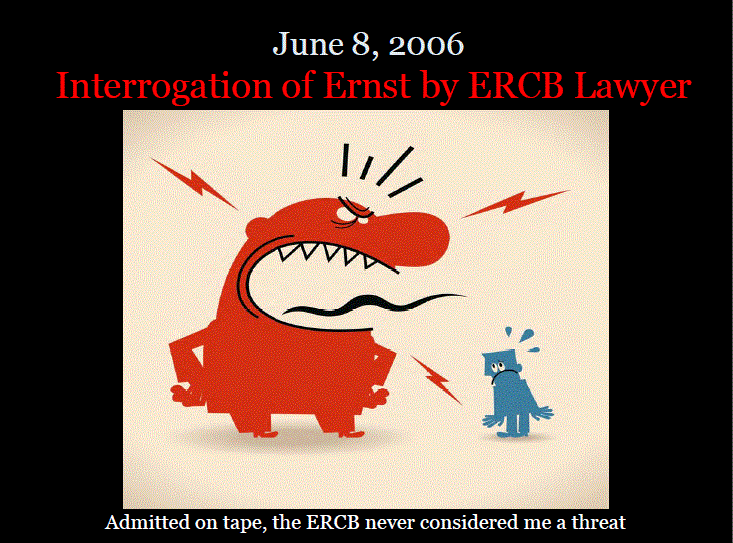
Ernst was judged by the EUB a “criminal” in 2005. ERCB outside counsel Glenn Solomon changed this to “terrorist” in 2012. Both judgements were completed by the regulator without any evidence, no charges, no arrest or fingerprinting by RCMP or any authority, no hearing, no trial. The regulator did not even asking Ernst to testify or submit a written statement. Ernst didn’t know she was being judged, until after the judgement was mailed to her, banishing her from energy regulation.
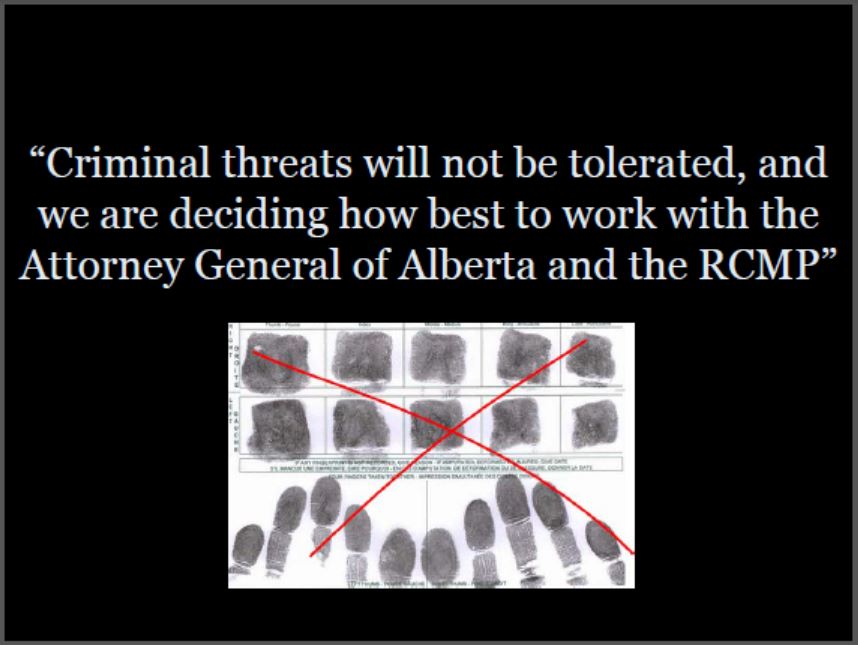
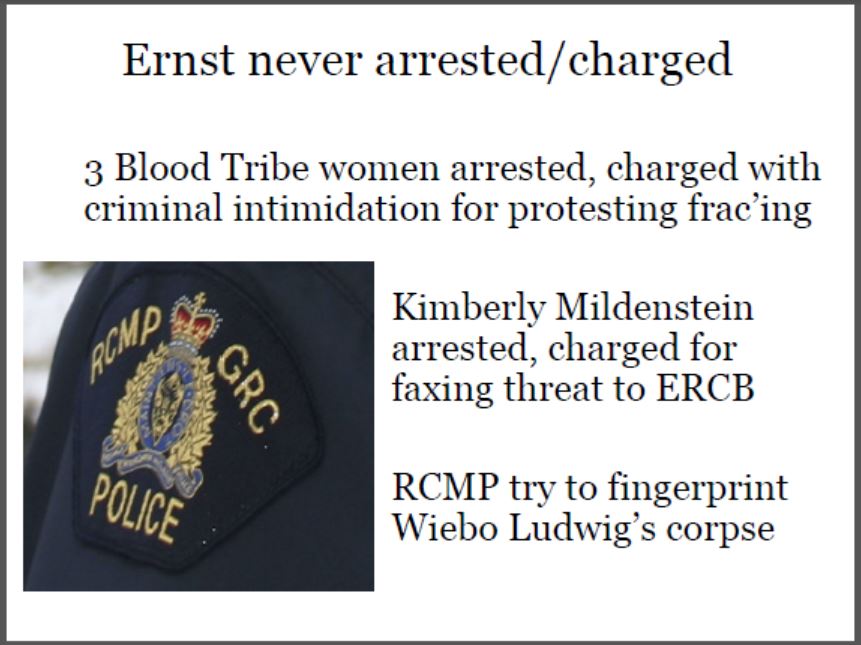
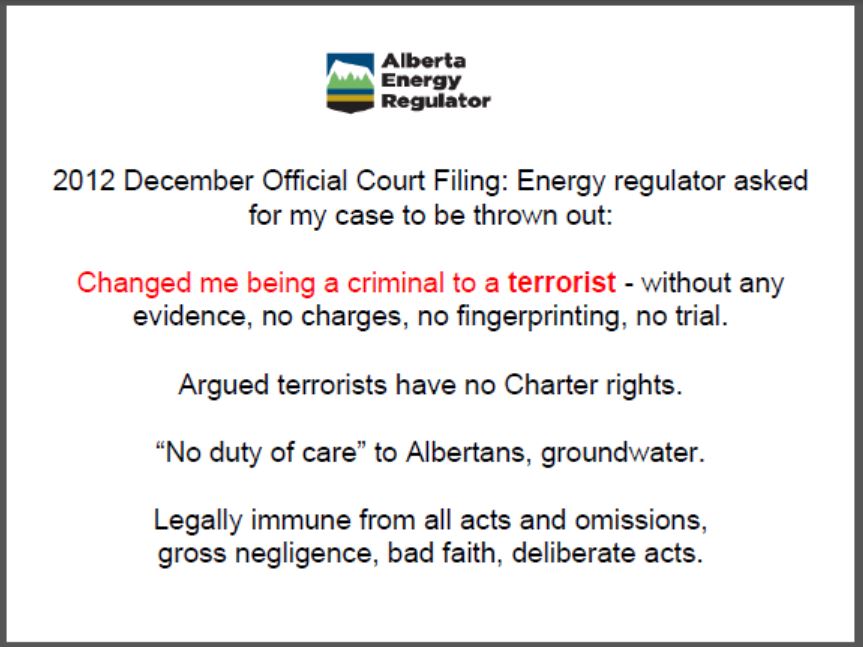
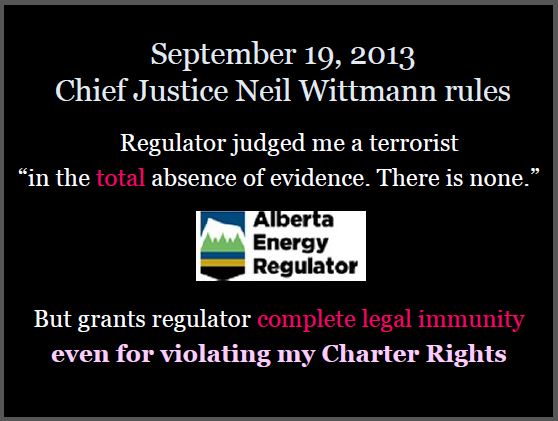

In 2017, the EUB/ERCB/AER’s judgement was magically transformed into “vexatious litigant” by Supreme Court of Canada Justice Rosalie Abella – also without any evidence, hearing, or trial, and also with no chance given to Ernst to defend herself to this judicial smear.


Slides above from Ernst speaking presentations
In 2013, Ernst ended her many public talks with Frac’d Lady Justice and posted the image to her website. Ernst’s lawyers, Cory Wanless and Murray Klippenstein did not quit then.
